
Road Network Operations
& Intelligent Transport Systems
A guide for practitioners!

Road Network Operations
& Intelligent Transport Systems
A guide for practitioners!
Back office processes match payment events with accounts, provide enquiry services, interfaces with banks and include many or all of the functions required to perform enforcement operations. Back office services include account management, enquiry handling, billing, legal support, interfaces to payment service providers and enforcement operations, shown in the diagram below. A back office represents a wide range of functions and administrative processes that follow well-defined business rules to create predetermined outputs meeting quality of service expectations.
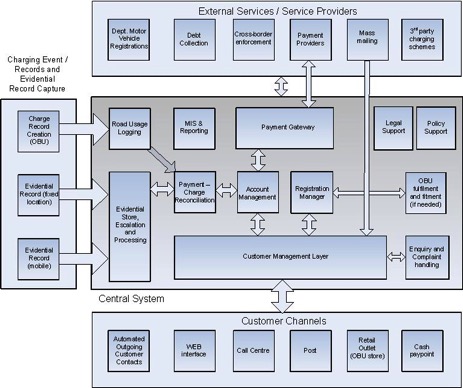
Many travellers will already be familiar with the activities of back offices in non-ITS areas such as banking, cable TV companies, utility companies and mobile phone network operators. The back offices of all of these organisations provide services based on time and usage. They maximising the opportunities for customers to acquire these services and pay for them, denying the service to users that do not comply with regulations.
For EPS, the back office consists of the Information Technology (IT) and core functions on which charging, enforcement and all external interfaces depend. As cash is replaced by non-cash MOPs it becomes necessary to provide systems, procedures, human resource management, to deal with the collection, analysis and allocation of EPS events to payments made or to user accounts. In general the functions that comprise a central system can be split into several areas:
It is not necessary that all functions need to be provided by the same organisation; this would mean that every bus company or toll road operator would need to develop its own complete back office. Standardisation can enable interoperability which allows for the management of a MOP to be totally independent from the transport services providers (See Standardisation and Interoperability).
Enforcement is the means of ensuring compliance with the regulations by deterring attempts at non-payment and providing the means to collecting outstanding payments. In most cases, the economic viability and sustainability of an EPS service depends on having an effective means of enforcement, which may mean using legal processes. If the accuracy of local or centralised database of vehicle owners is adequate then it becomes possible to reliably trace owners by capturing the image of a vehicle where there is non-payment (as evidence of a vehicle’s presence) which shows the Vehicle Registration Mark (VRM). This type of ‘evidential enforcement’ process needs to be trustworthy, secure and accurate.
One of the most effective forms of enforcement is to deny the delivery of a service to a user. For passenger transport a turnstile or gates may be used to ensure that a passenger needs to present a valid MOP before entering or exiting the public transport network. On a toll road and for off-street parking operators this means using ‘physical enforcement’ with barrier, as shown below, to prevent a vehicle entering or exiting a route until a valid MOP has been presented, including cash or some other form of identification. Alternatively, hydraulically operated bollards, as shown in the second picture, could be used to restrict vehicles within a city to specific types such as buses and taxis although these take many seconds to be raised and lowered.
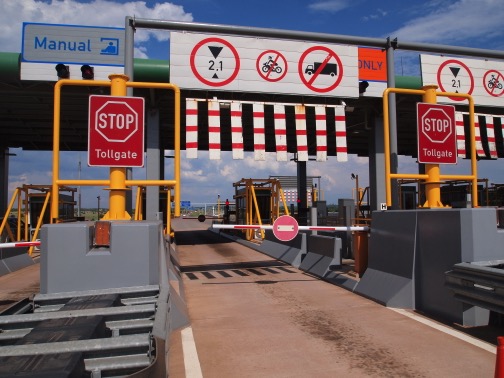
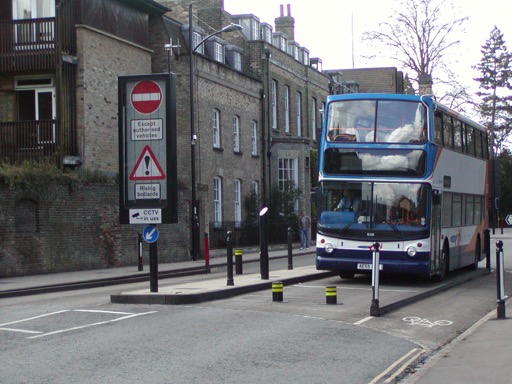
Although physical enforcement with barriers is an effective means of toll collection, it reduces the speed of vehicles and can only be used on the open highway without a toll plaza. Instead ‘evidential enforcement’ approach is necessary, based on overhead-mounted cameras shown below. The cameras are used to capture one or more images of any vehicles that is suspected of not complying with the regulations governing the use of the road – such as a vehicle that is not equipped with a tag, shown in the screen display in the second photograph.
Back office functions relating to camera enforcement include manual image interpretation, image storage, general legal support and image viewing facilities for staff authorised to issue fines or penalties. Note that an image of a vehicle may be regarded as ‘personal data’ and its use may be subject to local regulations on data protection (See Privacy).
If the toll road operator offers users’ accounts that are linked to a vehicle’s number plate, overhead cameras could perform the dual roles of video tolling and enforcement against non-payment. Optical Character Recognition (OCR) is used to interpret each image to extract the Vehicle Licence Plate Registration Mark (VRM) by a camera that is capable of Automatic Number Plate Recognition (ANPR) or the back office, or a combination of OCR at both, to allow enforcement to be partially automated such as the check of national vehicle databases.
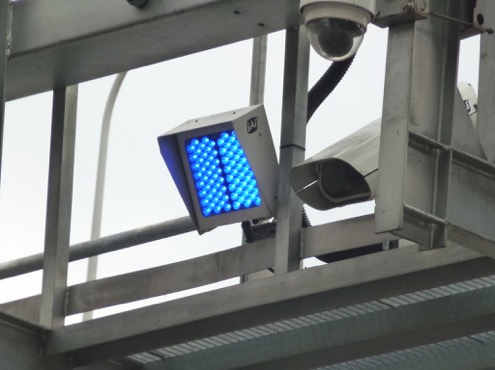
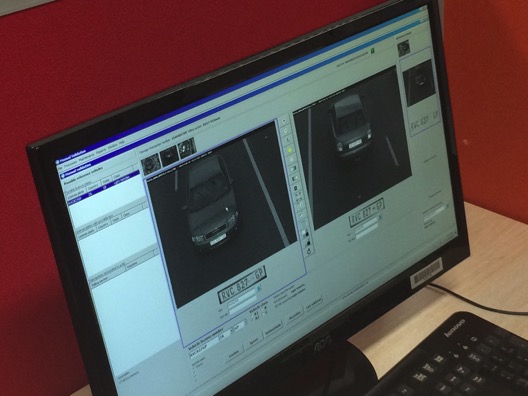
For truck tolling, enforcement against non-compliance may require a combination of fixed roadside systems, illustrated below, that combine all of the technologies described above. These methods may be reinforced with plus mobile patrols with vehicle-mounted or handheld equipment to interrogate the On-Board Units and capture Licence-plate. Transponders with visual or audible indicators are sometimes used to signal to the driver that he is permitted to bypass a weigh station without stopping based on historical compliance (as used in the US). At border crossings within customs unions, or on the approaches to weigh stations, the aim is to optimise inspections with the need to keep traffic moving (See Enforcement).
In 2014, Norway mandated the fitment of DSRC transponders on all HGVs to improve compliance checking, an advantage for enforcement operations in harsh weather conditions.
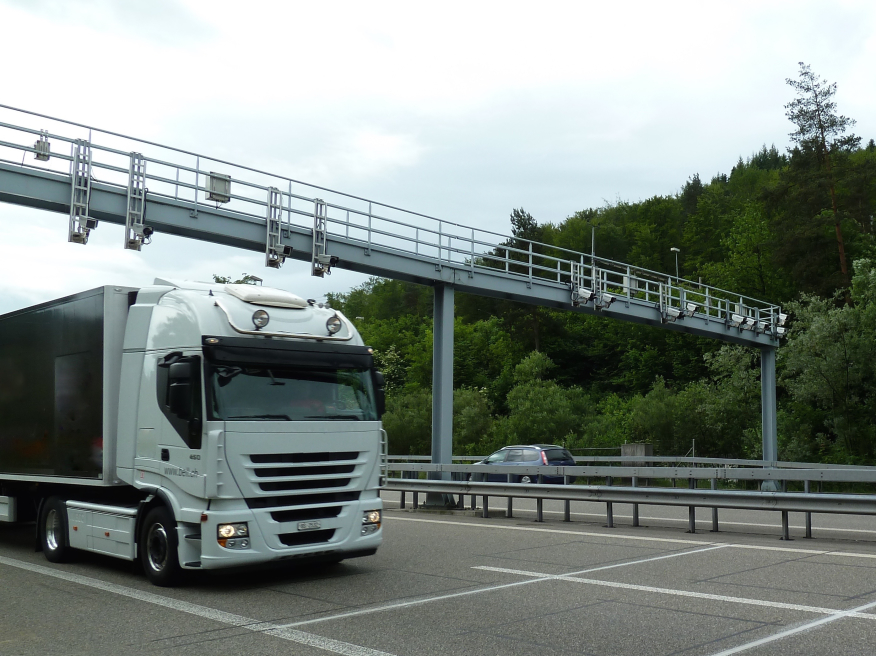
A successful Electronic Payment System is one that is widely adopted for transport-related services. This is likely to mean that a number of organisations will need to cooperate to deliver a comprehensive transport service, to a population that may have little or no experience of non-cash MOPs and where internet usage is low. Lack of expertise may prohibit a local authority or private toll road operator from selecting the most appropriate MOP or developing a procurement specification for back office services – particularly where interoperability is needed. Consultation with those who have been involved in commissioning comparable projects elsewhere is recommended.
Regions that have a high proportion of users on public transport offer a potential for successful use of non-cash MOPs. Examples are:
Operationally, the critical components of an effective enforcement regime are:
Historical data based on levels of compliance according to location, a vehicle rating system or other metrics can be used as the basis of ‘intelligence-based’ enforcement to ensure that scarce resources are used effectively. The same approach can be used for enforcement of HGVs route adherence and to reduce instances of cabotage by foreign-registered vehicles –made easier if there is cooperation with neighbouring countries.